If you think that what you’re inhaling when you “vape” is just a bunch of harmless fruity water vapor, you’re dead wrong.
That was Stacy Deeble-Reynolds’ main message at the first-ever Teen and Parent Conference hosted by the Fullerton Police Department on Saturday.
More than 100 people attended the Oct. 17 conference, which was organized by the PD’s Community Services unit to give parents and their teens the latest intel on some of the dangers hitting high school campuses these days so they could steer clear of them.
Workshops included the effects marijuana has on the developing brain, the downside of caffeine-fueled energy drinks and the evils of cyber bullying. The Fullerton PD received assists in putting together the workshop from the Orange County Sheriff’s Department, the NCADD-OC (National Council on Alcoholism and Drug Dependence), the Orange County Department of Education, and St. Jude Heritage Health.

Dr. Jorge Galindo, a licensed psychotherapist and psychoanalyst and a reserve deputy with the Orange County Sheriff’s Department, talks about the effects marijuana has on the developing brains of young kids and how marijuana has been altered over the years, at the Fullerton PD’s first-ever Teen and Parent Conference on Oct. 17.
Photo by Steven Georges/Behind the Badge OC
Vaping is the latest teen temptation, according to Deeble-Reynolds, prevention coordinator for the Orange County Department of Education, and it’s gaining steam.
Deeble-Reynolds’ job is to work with all 27 of Orange County’s school districts, educating staff, parents and kids about drugs and alcohol. She teamed up with the Orange County Sheriff’s Department to put together a traveling workshop on vaping.
“It’s a roadshow, if you will,” she says.
The roadshow began after a California Healthy Kids Survey in the 2013-14 school year showed vaping on the rise on OC campuses.
“We were shocked,” Deeble-Reynolds says.
The survey showed that whereas 3 percent of all 7th graders in Orange County reported smoking a cigarette, 12 percent had inhaled an e-cig, a battery-operated device that looks like a traditional cigarette. Twice that many ninth-graders had vaped. And while 18 percent of 11th graders had smoked a traditional cigarette, 33 percent had used an e-cig.
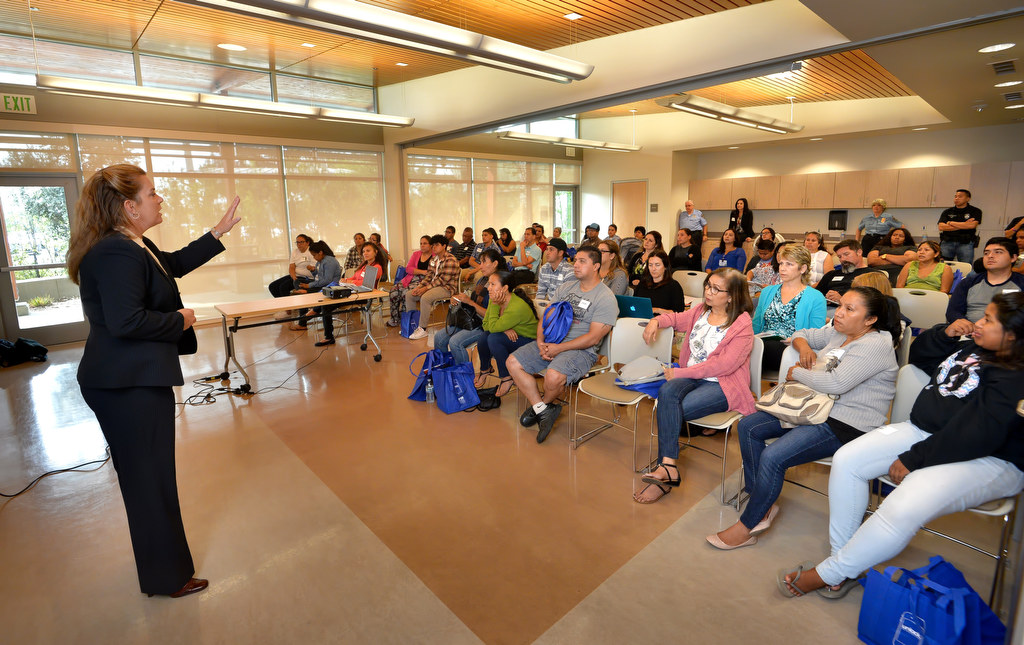
Det. Carin Wright, a corporal with the Fullerton PD, talks to a class of parents on Social Media & Cyber Safety during the Fullerton PD’s Teen and Parent Conference.
Photo by Steven Georges/Behind the Badge OC
“We knew they were on the scene because schools were reporting confiscating them, and they didn’t even know what they were confiscating,” Deeble-Reynolds says.
Schools then were getting calls from parents angry that their kid’s device was taken away, and demanding it back.
“So there was a lot of educating we had to do,” Deeble-Reynolds said. “This confirmed our concerns. Vaping is wildly popular in Orange County. We needed a plan of attack.”
The biggest misconception is that vaping involves harmless fruity smelling water vapor.
“Nope,” she says.
Vape pens (or cloud pens) have cartridges that you fill with “juices” that are often concocted in the back rooms of vape shops, or sometimes mixed in vats in garages and then sold to shops.
At this time, the shops are not regulated and the FDA does not monitor the contents of the juices, so there is no one making sure the mixing is sterile, or scientific.

Araceli Gonzalez,who has a 10-year-old daughter, listens to Fullerton detectives talk about Social Media & Cyber Safety. Photo by Steven Georges/Behind the Badge OC
Depending on the “juice,” it can contain chemicals found in traditional cigarettes, plus more.
Deeble-Reynolds showed a chart with a long list of some of the chemicals that have been found in various vape juice concoctions, many which have been listed by the FDA as carcinogens. They include arsenic, formaldehyde and aluminum. The juices can also contain nicotine.
“Advertised nicotine strength is not always what the user gets,” Deeble-Reynolds says.
A traditional cigarette has about 12 mg of nicotine. An e-cig can have anywhere from zero to 48 mg.
“The e-cig, it’s the Wild West,” she says.
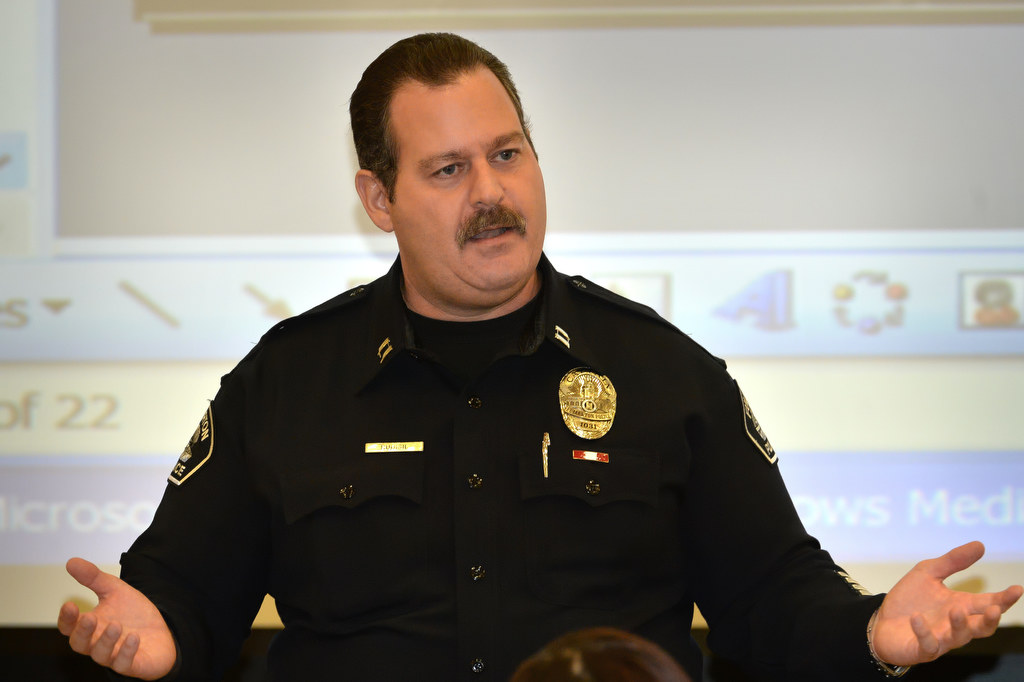
Capt. Scott Rudisil of the Fullerton PD welcomes parents and kids to the PD’s first-ever Teen and Parent Conference at the Fullerton Community Center Oct. 17.
Photo by Steven Georges/Behind the Badge OC
Unlike tobacco, which was banned from TV ads more than 40 years ago, the fresh-on-the-scene vape industry — some vape businesses are owned by tobacco companies —can advertise wherever it wants.
The target audience: Clearly, youth.
Deeble-Reynolds showed one cartoon ad that depicts Santa vaping with the slogan, “I don’t always vape, but when I do, I choose Vapor Shark — Kris Kringle.”
“It’s below the belt,” Deeble-Reynolds says.
One company called Blu has just come out with a “social feature,” a new form of advertising. If you have a pack of their e-cigs in your pocket and you come close to another person with e-cigs, your packs buzz and light up. It does the same thing if you get close enough to a store that sells the product.
“One of the things that young people struggle with is building connections,” Deeble-Reynolds says. “This preys on people who have a desire to connect with others. To make friends. It’s an instant connection.”
And then there are the flavors.
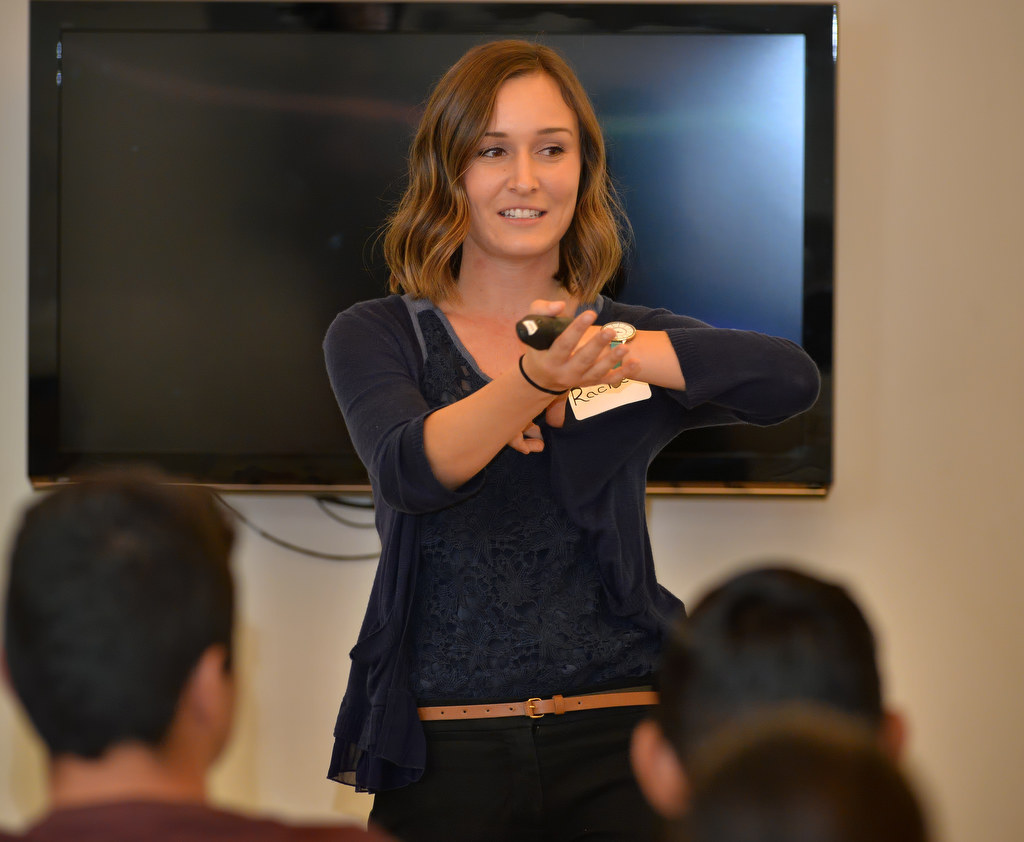
Rachel Mayer, a health educator with the National Council on Alcoholism and Drug Dependence – Orange County, talks to kids (ages 9-13) about resisting peer pressure to use drugs and alcohol at the Fullerton PD’s Teen and Parent Conference Oct. 17.
Photo by Steven Georges/Behind the Badge OC
Vape shops sell juices with fun-sounding names like Boom Boom Pop (firecracker popsicle flavored), Lovely Bubbly, Candy Cane and Crave Chocolate Chip Cookies. Their scents are just as yummy.
“Little children are trying to drink these. It smells good. It tastes sweet. And suddenly you’re in the hospital,” Deeble-Reynolds says. “There are more and more calls to poison control. This should not be OK.”
Ninety percent of today’s adult smokers started smoking before they turned 18, Deeble-Reynolds said, quoting a Centers for Disease Control stat. So it behooves the vape industry to get someone hooked in his or her teens.
It is illegal to sell vape juice to minors, but there is no law on the books regarding how old a person must be to vape.
Right now there are about 200 vape shops in Orange County.

Viviana Mondragon of Fullerton talks to her 13-year-old son, Joseph Espinoza, as the conference gets under way.
Photo by Steven Georges/Behind the Badge OC
In another presentation at the conference, Dr. Jorge Galindo, a licensed psychotherapist and psychoanalyst and a reserve deputy with the Orange County Sheriff’s Department, talked about the effects marijuana has on the developing brains of young kids and how marijuana has been altered over the years.
And Det. Carin Wright and Det. Cynthia Hines of the FPD discussed cyber-bullying, social media and peer pressure.
The effects of cyber-bulling on victims, they said, include anxiety, depression, stress-related disorders, suicide, withdrawal from friends and activities, changes in mood, behavior and appetite, and emotional distress during and after using technology.
And the officers stressed that engaging in cyber-bullying has serious consequences, with perpetrators facing possible misdemeanor charges of sending annoying or harassing texts of felonies for making criminal threats or distributing obscene material.
The officers directed parents and their teens to the following resources:
oag.ca.gov/cybersafety/online/cyberbullying
stopbullying.gov/cyberbullying/index.html
For more information and videos on vaping, go to notsosafe.org, a website created by the Department of Education in partnership with the Orange County Sheriff’s Department and the Orange County Health Care Agency.
Deeble-Reynolds is currently working with the Sheriff’s Department to put together a new workshop, this time on marijuana and youths. It hits the road Jan. 7.
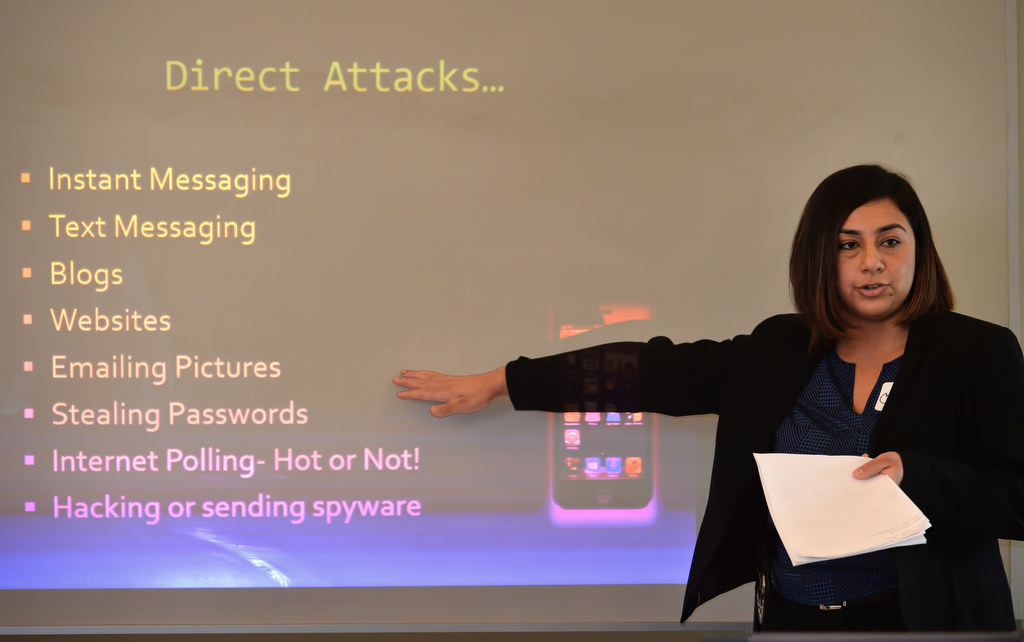
Det. Cynthia Hines, a corporal with the Fullerton PD, talks to a class of parents in Spanish on Social Media & Cyber Safety.
Photo by Steven Georges/Behind the Badge OC
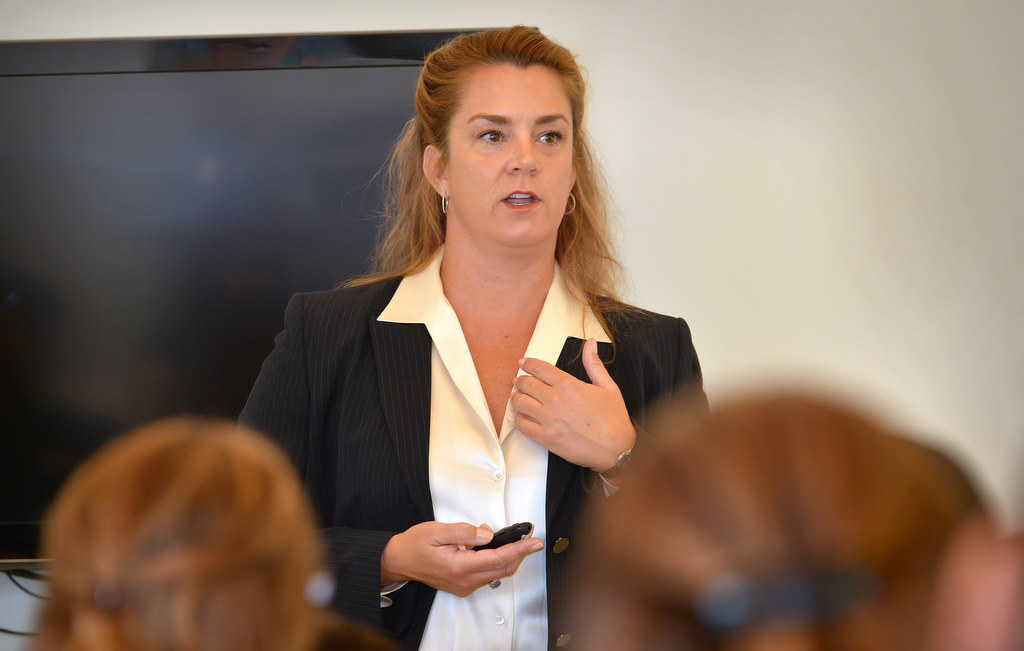
Det. Carin Wright, a corporal with the Fullerton PD, gives a presentation on Social Media & Cyber Safety.
Photo by Steven Georges/Behind the Badge OC

From left, Dr. Jorge Galindo, a licensed psychotherapist and psychoanalyst and a reserve deputy with the Orange County Sheriff’s Department; Lucia Maturino, a community liaison officer with the Fullerton PD; Al Valdez, a professor at UC Irvine and a nationally known expert on gang sociology and psychology; Sgt. Kathryn Hamel, PIO for the Fullerton Police Department; and Capt. Scott Rudisil of the Fullerton PD. Photo by Steven Georges/Behind the Badge OC
 Behind the Badge
Behind the Badge



